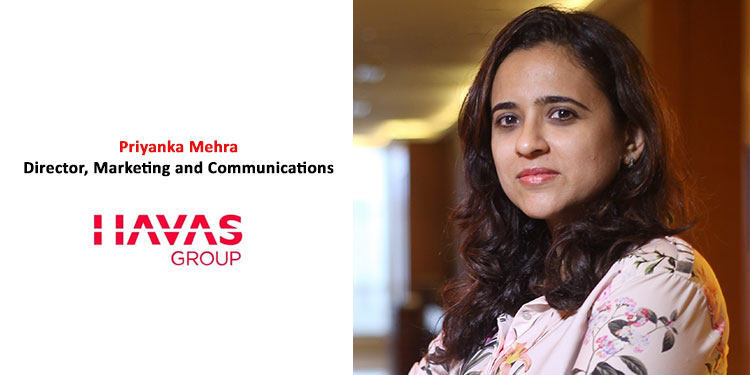Whilst video calls seem a necessary evil now, they have delivered some valuable lessons,‘if’ we choose to learn them, writes Priyanka Mehra Director, Marketing and Communications, Havas Group India in her column as shares her takeaways on making this medium as meaningful as possible currently and leveraging best practises once the world opens up.
Like many, Zoom and I were long-distance friends in the past, we interacted over weekly calls with global teams. Over the past few months, our friendship has touched new heights and we are spending a lot of quality time daily. And it seems, I am not alone, people spent an average of three hours and 12 minutes each week on video calls – an increase of 120 percent compared to before lockdown, according to a study commissioned by Bayfields Opticians & Audiologists.
Today when I hear someone say Zoom, my first thought is human faces with varied expressions in rectangles, (Equality has been achieved at last – virtual video calls are designation agnostic, so everyone gets their piece of land)
“Am I audible can you hear me?” (READ- I can’t tell from your expression, so please confirm you can hear me) and “Can you see my screen?” (READ- Need reactions to what I am sharing- worked hard on this presentation) have been successfully added to my primary vocabulary as well.
Since the end to WFH is nowhere around the corner, at least for the next few months it bodes well to maintain friendly relations with your preferred choice of video calls.
My takeaways to making this medium as meaningful as possible currently and leveraging best practises, once the world opens up–
- Making it as close to an “actual” meeting as you can – Lack of engagement is the biggest challenge when it comes to virtual meetings/ pitching conversations which is why it is important that you can see everyone. This translates to being aware of where your camera is, making it hard for anyone to be distracted and provides more exposure to facial expressions and body language, which helps in overall communication and staying engaged throughout.
- Dressing with intent – Till our schedules once again fill in with business meetings albeit physically distanced ones, cracking the ‘virtual look’ is the daily new normal.
Given the challenge we are trying to adapt to over the past few months, like trying to gauge reactions through nonverbal cues, we subconsciously picked up when we met pre-pandemic times, sometimes getting it right and sometimes not.
I find the concept of ‘dressing with intent’ extremely applicable more now than ever, dressing as I would for a non- virtual business interaction gives me an added level of confidence and ease.
- Plan the meeting around the discussion virtually……. Keep it shorter! – The challenge of different individuals using different types of technology and using different internet bandwidths, can be addressed to some extent by ensuring that decks and videos are shared prior to the call so that the meeting time can be used for discussion and answering questions, instead of struggling with the internet that decides to go truant just the moment you are primed to present.
One boon of designing meetings around discussions is the length of the meeting is shorter(read more productive) this is specially appreciated when there are teams from different time zones on. The person who is just beginning their day in New York and the one ending their day in Australia are collectively thankful to you for this.
- The combination of voice and design matters more than ever! – Keeping copy to the minimal on slides, clear fonts, and bold headlines, and using more imagery, a few quirky quotes to sometimes lighten the mood and allow for more conversation.
Small fonts heavy duty detailed charts that are difficult to read, could be avoided and replaced with videos wherever possible. Also, no harm, in a bit of voice modulation, given that all the audience has is your voice and the slides on the screen.
- Mute it … please! –Mute your microphone if you are not emphatically making a point please, more out of respect for the other person speaking.
While it is very natural for video call or ‘zoom fatigue’ to set in given the many months and sheer volume of time we are spending on this medium, but what it undeniably brings is connectivity in real time, the best sense of collaboration we can have currently, and by default much lower business costs.
No debate on video calls coming nowhere close to being, a complete replacement to actual physical meetings, once the world opens up. But given that we now, know what can be achieved via video calls we will now, choose to travel wisely, have shorter and more productive meetings, optimise our time on working distantly when that works best.
The optimist in me also believes and hopes we become more mindful, and actually listen when a colleague is speaking and hear his or her idea out, on the back of learning to mute our thoughts momentarily and respect someone else’s by listening instead of constantly intervening.
Become more creative in our presentations, the impact and effect of ‘audio theatre’ as we know it, only adds to a better narrative and storytelling. Yes, video calls seem a necessary evil now, but have delivered some valuable lessons if we choose to learn them.
Authored by Priyanka Mehra, Director, Marketing and Communications, Havas Group India.
















